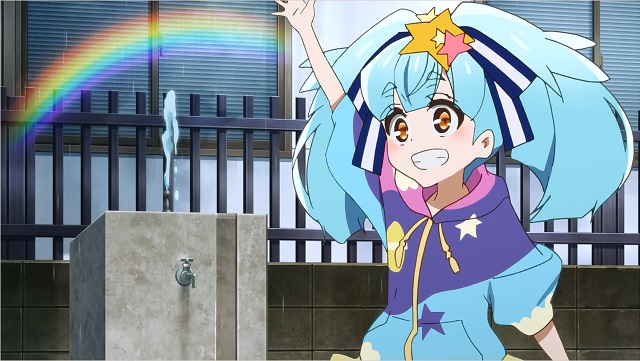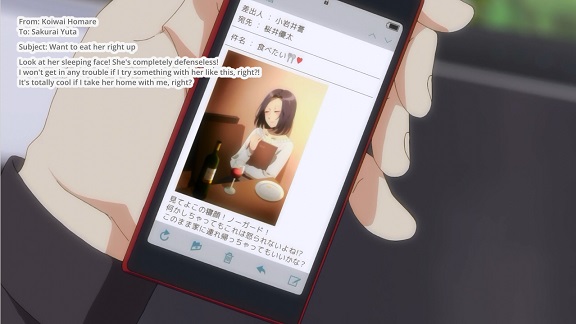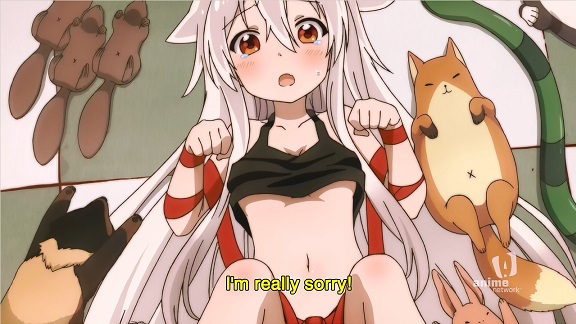Does what it says on the tin. Adorably cute despite the occasionally awkward English.

Does what it says on the tin. Adorably cute despite the occasionally awkward English.

The rise and rise of isekai is the most important thing to happen to anime in this decade.
Not that the concept of isekai is new to this decade of course. Stories about people being dragged away with the fairies or kidnapped by the gods are as old as storytelling itself. Even if we limit ourselves to anime, there’ve been series Like Rayearth, El Hazard, Escaflowne, Fushigi Yuugi, Garzay’s Wing coming out decades before the current isakai boom. So what sets the current crop of people being transported to another world from the older kind?
Formula.
Like so much that’s bad in anime, you could blame it all on Sword Art Online. There had been other stories about people trapped in a videogame before (.Hack), none was such a monster as SAO turned out to be, both in Japan as over here. It came out at just the right time, as streaming had become mainstream and it had everything a proper wish fulfilment series needed. You had the protagonist, a video game nerd the sort of people who watch anime could easily identify with and the setting, a fantasy video game world ala World of Warcraft, but in virtual reality, which a lot of the people watching it would give their eye teeth to be trapped inside in of. Add a handful of potential love interests and ultimately quite a nice romance between Kirito and Asuna. And while it’s often treated as if it was the worst anime series ever, it had a certain quality to it. The first story arc was what hooked people on the series and while everything went downhill afterwards, it pointed the way forwards.
And again, while it wasn’t the first, Sword Art Online also popularised and made mainstream what I call the Otaku Industrial Comples. It started as a self published web novel, was cleaned up and rewritten as a series of light novels, then finally got manga and anime adaptations. If you look at any isekai series published after SAO, you see the same route over and over again. And for every one that got an anime adaptation, there are zillions more that remained as web novels.
The way these series are created, largely by fans for fans with the most popular taken up and getting light novel and manga adaptations before being turned into anime, shapes them intimately. The reason that all those isekai animes seem the same is because that is what survives this meatgrinder. Readers and publishers both aren’t looking for originality or quality, they just want more of the same, variations on a formula, some clever new hack on an old story, as long as it’s not too different.
So what you get are variants in set up, where the protagonist’s gimmick may be different but the worlds are all the same and the stories all follow the same pattern. You got your over powered protagonist, either reincarnated into or transported to a fantasy world shaped by Japanese RPG tropes, usually with some sort of demonic overlord threatening humanity, but where the bulk of the story is made up by the hero becoming an adventurer, complete with guild issued card. Sometimes the hero is just supremely overpowered that nothing is a challenge, sometimes he has a hack power everybody else thinks is worthless, sometimes he is a demon lord himself, or a sword, or a hot springs, but in any case he’ll become an adventurer with a team of powerful but not too powerful female team mates. Who often are some sort of slave, but happy slaves as he is a good master.
You expect all this to be mined out as quickly as any other subgenre suddenly becoming popular and spawning a host of imitators, but so far it hasn’t burned out yet. There were about half a dozen isekai series in last season alone, few of them particularly interesting. and next year will be more of the same.
To be fair, I don’t actually mind reading or watching the occasional mindless isekai series myself. There is actually something comforting watching this sort of unchalling, by the numbers series, where you know the hero will always win, no challenge will be particular difficult and if anything else, there will always be some cute girls to look at. But what I’m really looking forward in isekai is the rise of a new subgenre, not yet present in anime: the otaku girl who finds herself reincarnated in the world of her favourite boys harem game, as the villainess. There have been several light novel and manga series using this gimmick in the past couple of years and they’re all more interesting than the usual isekai story. Especially My Next Life as a Villainess: All Routes Lead to Doom!, where the protagonist reincarnates as the six year old villainess and sets about evading her bad ends, without ever realising she’s building herself a harem in the process. the anime version comes out next year: I cannot wait.
This is day twelve of Twelve Days of Anime 2019.
2019 was the year of this ridiculously cute dance.
2019 was also the year of watching much less anime for me. There are various reasons for that. I’ve become more discerning in what I want to watch, I’ve found myself watching other things more (football, tokusatsu, etc) and I’ve found myself just not that interested in keeping up so much. Even when I watched anime, it was mostly the low effort series I found myself watching, rather than the ones where you actually have to keep your brain actively engaged.
So I’ve started but not finished series as Mob Psycho 100 season 2, Dororo, Yakusoku no Neverland, Fruits Basket or Carole and Tuesday. Instead, what I watched were things like Endro, Miru Tights or Sounan Desu Ka?, none of which required much effort to watch. Anecdotically, I’ve always heard that the average anime fan watches seasonal anime for roughly two years, so this seems right on schedule, having done so since Fall 2015. Whether this is the case for me I’m not sure yet, but in any case it leaves me struggling to say much about this year.
One excellent series I did watch but never heard anybody talk about was Rilakkuma to Kaoru-san, a stop-motion (!) series brought out on Netflix, which I discovered purely by accident while browsing through their anime catalog. I put on the first episode and before I knew it had watched the entire series. Thought his series about a living stuffed teddy bear, his friends and “owner” sounds whimsical at first, there’s actually a hard headed realism to the series. The titular Kaoru-san is a twentysomething office lady working a dead end job with co-workers who are only there to get a man, only to be nagged by her mother to come back home and take over the wine farm. Lonely, borderline depressed and the butt of everybody’s joke, she survives on the love of her stuffed animal companions. A somewhat bitter series to be honest, but sometimes that’s just what you need in the endless sea of ganbare! and youth drama.
But that’s all I have to say about 2019.
Stats: 131 series in my library, quite a few less than in the last few years, 59 watched. As said, I watched a lot less anime this year than I used to.
This is day eleven of Twelve Days of Anime 2019. Tomorrow: summing up.
2018 started with a high school girl indulging her penguin fetish.

Sora yori mo Tooi Basho was the anime of the year for me. Tamaki Mari is a very ordinary second year high school girl who one day suddenly realises that she’s a very ordinary second year high school girl. She wants a cause and finds it in Shirase, obsessed with getting to Antarctica, because that’s where her mother died three years ago. Together with Hinata, who dropped out of high school and who was looking for something interesting to do before she takes college entrance exams and Yuzuki, a child actress/idol whose company though it would be a great stunt to send her there, they do go to Antarctica. Free from the usual anime bullshit, this is by turns incredibly fucking funny and emotionally devastating, especially the penultimate episode, when Shirase comes to terms with her mother’s death.
Another early 2018 anime that left me emotionally devastated: Devilman Crybaby. That came out very early in January on Netflix. For about a week after my Twitter timeline was full of happy, queer monster girls as everybody watched and got invested in it. So on the last weekend of my holidays I sat down and watched it too and realised it was all a lie. There were no happy endings, just the bleakest depiction of humanity self destructing I’ve ever seen in anime. It took me a good solid day of happy fun slice of moe series to get my mood back up again.
Luckily there were a lot of those. Yuzu Camp was about a girl who likes to go solo camping in winter, as well as about the camping club at her local high school, who go camping together. It was all incredibly comfy and good natured and made even something as mundane as eating ramen at a campfire look epic. Mitsuboshi Colors was about three little girls getting up to mischief and was hilariously funny in how shitty these three could act. Hinamatsuri had a similar sort of energy to it, if more deadpan. It also took a right turn into the plight of the homeless in Japan halfway through, which sounds strange but worked. There was Ramen Daisuki Koizumi-san, about a girl who loves eating ramen and her friend/stalker who loves her very much. There was Slow Start, about a girl who had to skip a year between middle and high school and is terrified people might find out and Hakumei to Mikochi, two literal little women being only a few centimers tall living together in a magical world. And then there was Uma Musume: Pretty Derby about literal horse girl idols who do actual horse races followed by idol concerts. It was better than it sounds.
Comic Girls was a show about an anxiety ridden high school mangaka who on the suggestion of her editor starts living in a dorm with three other high school mangaka. Equally insecure and thirsty, Kaos was actually a thinly disguised, hopefully exaggerated version of the original manga’s creator. Most of the show was well animated, fluffy fun, but Kaos’s anxiety is handled seriously. The same goes for the attraction Kaos has for one of her dorm mates. It’s this that made comci Girls standout from the crowd of slice of moe series this year.
In 2018, both Aikatsu and Pripara revamped themselves, starting new series. Aikatsu Friends mainly followed the same formula as the original Aikatsu and Aikatsu Stars, but Kiratto Pri☆chan changed its magical idol setup for more of a Youtube idol setting. Neither were officially released here and the fansubs for the latter have been disappointing too. There was also Layton Mystery Tanteisha: Katri no Nazotoki File, a kids detective show starring the daughter of professor Layton. Venerable youkai manga Gegege no Kitarou also got a new series. But the biggest kids show remained Precure and Hug tto! Precure was one of the best entries in the franchise. Unabashedly queer, giving us the first boy precure, who was introduced as genderqueer and who had a boyfriend in the brother of one of the Cures as well as what was clearly a lesbian couple with Emiru and Lulu, as seen above. It was of course never spelled out as such but it was there.

Biggest anime “controversy” of the year was about Zombieland Saga, when one of the characters, the cheerful Lily, was revealed to be trans and to have literally died of gender dysphoria. First, there were the usual rightwing assholes who insisted it was all made up by the “sjws” at Crunchyroll, which is par for the course if no less irritating for it. But then things got surreal. One particular image of Lily, with a badly photoshopped gun in her hands and the text “shut the fuck up, terfs” became widly used whenever some transphobe spouted hatred on twitter. This image then was used as evidence of how transphobes are “oppressed”, used by a transphobic SNP MP in the British Parliament!
Statistics: 183 series in my library, 131 watched. I started having trouble keeping up with seasonal anime in the latter part of the year, as I started a new assignment and just couldn’t bring myself to watch anything, let alone series I had to actually pay attention to. There are quite a few good series I still need to finish, like To Be Heroine, High Score Girl and the new FLCL sequels.
This is day ten of Twelve Days of Anime 2019. Tomorrow: 2019 is not actually over yet.
2017 showed that a great vision, storytelling and characterisation could overcome bargain basement animation.
Kemono Friends was made on a shoestring budget by a studio that barely employed a dozen people, as an ad for a mobile game that had already been shuttered. It became one of the biggest critical and commercial successes of 2017because it had something many much more slicker anime lacked: heart. The simple story of a girl waking up without memories in the over grown ruins of a futuristic safari park, befriending a serval catgirl and going on a quest to find her origins was enough to hook people. It proved how effective a good setting and not being too quick to answer questions could be in keeping people interested. But it wouldn’t be half as good without the friendship between Kaban and Serval.

Biggest disappointment of the year has to go to Shingeki no Bahamut: Virgin Soul. The original Shingeki no Bahamut had been a nice fantasy romp and this started out strong as well despite missing Favaro, the original’s best feature. Instead we got a new protagonist, a half dragon girl just trying to earn a living in the capital with her inhuman strength. Best part of this was our heroine blushing and threatening to “hulk out” everytime she saw a bloke she fancied. But that all was traded away for a boring plot of humans oppressing both the angel and demon races after having gained the upper hand at the end of the first series. The villain responsible was boring but the series loved him and kept him winning and when I learned he was “redeemed” in the end with no consequences for his genocide, I checked out. Still got seven episodes to go but no desire to finish it.
Other disappointing sequels this year: Seiren, spiritual succesor to Amagami, one of the better harem romances. This time around it focused too much on the former’s penchant for strange fetishes and not enough on the actual romances. I didn’t like the tournament arc in the new Boku no Hero Academia season either. Most of those are a waste of time. Worse than that though was the remake of Kino no Tabi, for which the light novel fans got to vote for the stories to be adapted. Unfortunately that led to a certain incoherence compared to the original, while the adaptation itself was both bland and worse, took liberties with Kino’s gender. Kino after all is ungendered or non-binary, neither boy nor girl, but the new series seemed determined to undermine this, refering to them explicitly as a girl multiple times.

One series everybody loved but I didn’t was Net-juu no Susume. As I said in 2017: MMO Junkie is rape culture. You got the protagonist, a woman who plays a male character online, being manipulated in a date with one of her co-players, a bloke who plays a female character in the same game. He knows or suspects she is his fellow gamer; she doesn’t. It was all very icky especially with the rape jokey text shown above. A pity, as so much of the series was great otherwise. On the whole I ended up like the high school romcom Gamers! better: funnier, more sympathetic characters and no rape jokes.
Speaking of high school romance, both Tsuki ga Kirei and Just Because! were great examples of how to do one right. Both stayed away from the usual anime cliches, were a bit more realistic in their setting and characterisation. Both had some seriously good animation too, always in service to the story. Both also managed to break my heart a bit, especially the former, where the love triangle that had been created was resolved in the most realistic way possible. No endless spinning out, it was clear from the start only one person could win but it still hurt to see the other lose their love. Both in the end proved you could tell a satisfying romance with a proper ending in just twelve episodes.

On the slice of moe front, nothing was as moe as the pair of moeblobs and their kettenkrad travel around a post-apocalyptic wasteland in Shoujo Shuumatsu Ryokou. That particular series was the sort of melancholy that only the Japanese seem able to do, somehow finding a bit of healing in the death of humanity. Urara Meirochou was a more traditional slice of moe series, about four apprentice storytellers in a magical city steeped in Japanese mythology. Also a bit of yuri never hurts. Kobayashi-san Chi no Maid Dragon took a somehwat crap manga and made something beautiful out of it, as expected of KyoAni, creating a story about a working too hard software developer, her dragon maid and the dragon daughter they adopted. Frame Arms Girl did something similar, but with a high school girl and the intelligent, living action figures a friend sent to her to test. Action Heroine Cheer Fruits was a fun series about a couple of friends putting together an amateur hero show to promote their town. Dive was a rarity, a Free knockoff with lesser animated pretty boys going diving. Konohana Kitan was another Japanese mythology based series, this time about a fox spirit going to work at a traditional Japanese inn.
Unexpected gems this year included, of course, Houseki no Kuni, about genderless gem people fighting against alien abduction by what looked like Hindu=-esque gods.But also Animegataris a school club series that seemed to celebrate anime/otaku culture until it took a sharp right turn into showing what happens if you dive too deep into it. 18 If was a sort of anthology series about a guy who has to rescue all sorts of damsels in distress, stuck in dreams. Hit and miss, some of the episodes had some of the best animation I saw all year. Quanzhi Gaoshou was a Chinese series released here through Youtube, about a guy kicked off a pro-gaming team and making his way back. Kabukibu! was about a high school kabuki club and was surprisingly inclusive and supportive.
2017 in general was a strong year; some of the best series I haven’t even mentioned yet. Little Witch Academia would be my personal best series of the year. If only because my little niece watches it on Netflix. Well animated, well written, accesible without being patronising, this hit all the buttons for me. I even went as far as saying that LWA fanfic kept my sane that year.
Statistically, there were 163 series I wanted to watch this year, down ten from last year. I watched 148 of them, which does actually make it a better ratio than last year of 173/152. A scary amount of anime in any case.
This is day nine of Twelve Days of Anime 2019. Tomorrow: 2018: a year of moe.